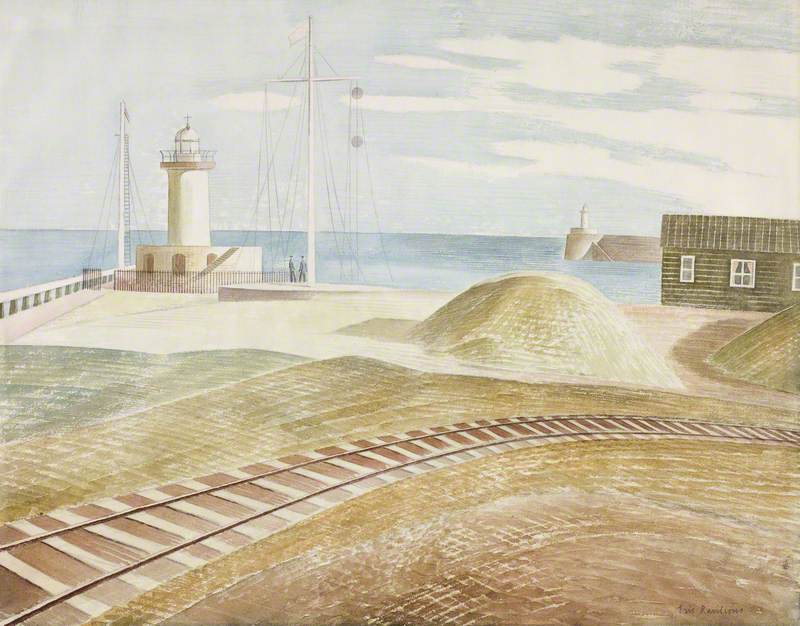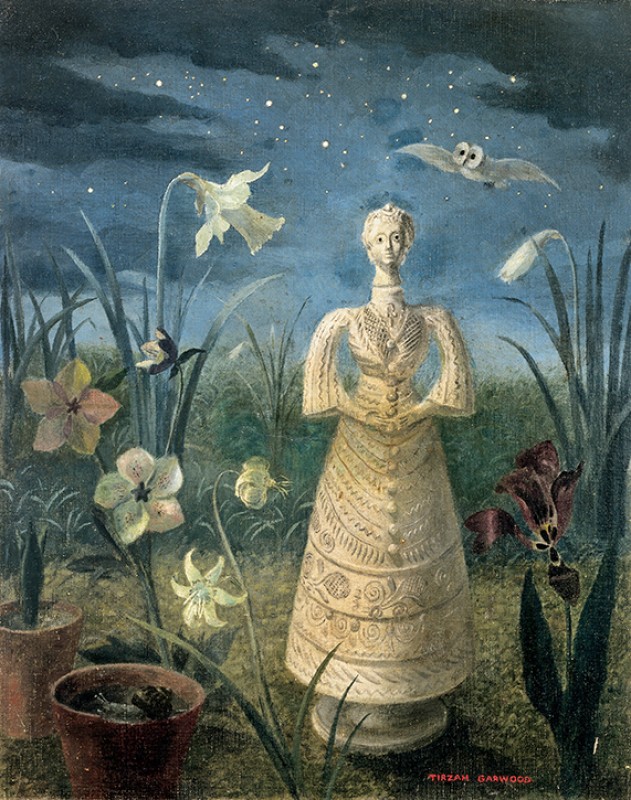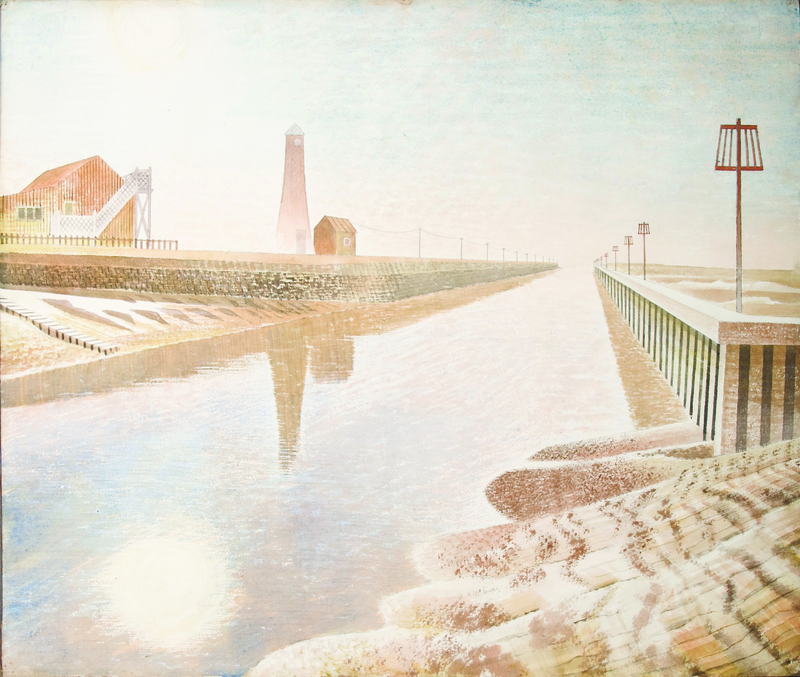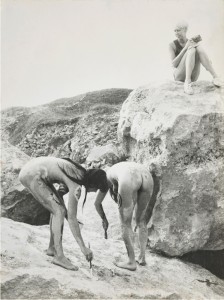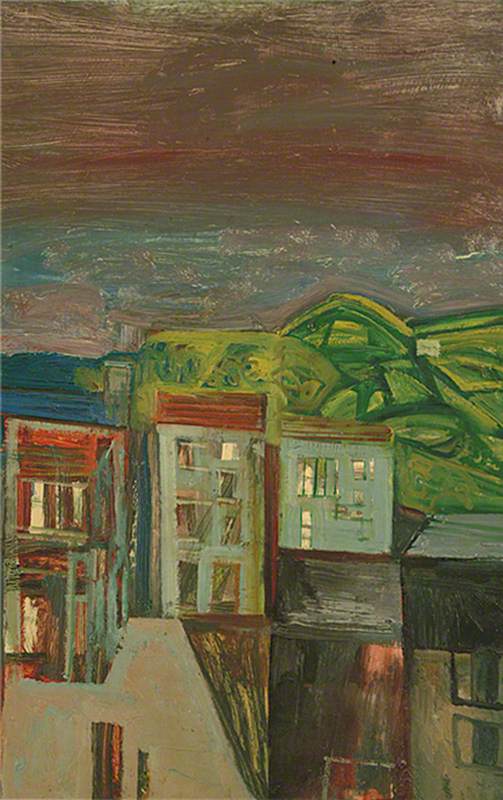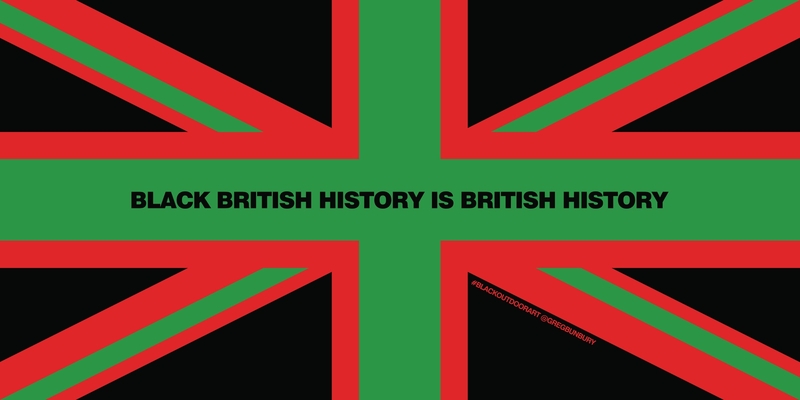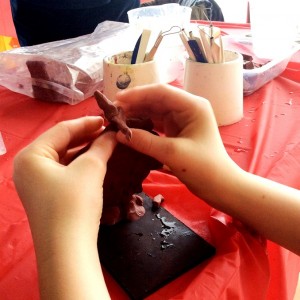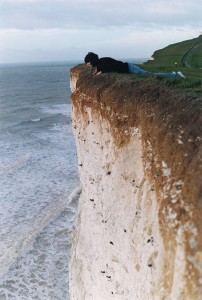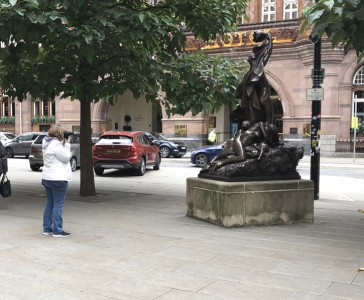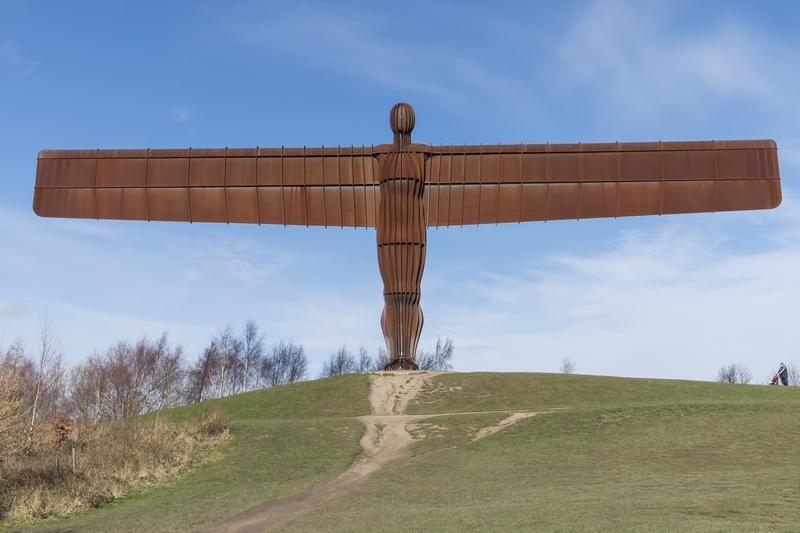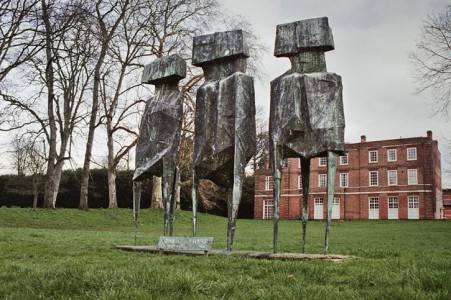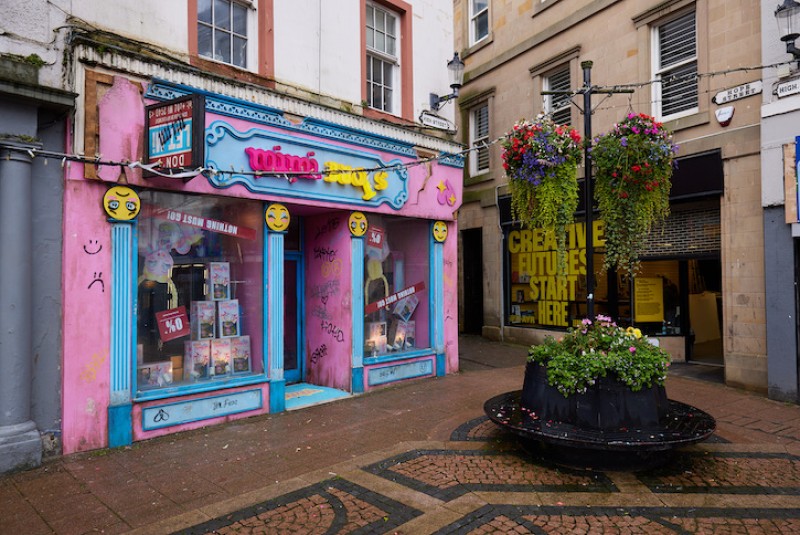For the British artist, designer and illustrator Eric Ravilious (1903–1942), location was at the heart of his work. He drew inspiration for his extensive body of work from the places he lived and worked during his short life. He is best known for his watercolours of the South Downs and the Essex villages around his later home in Great Bardfield.
Born in London but brought up in Eastbourne, Ravilious had a strong connection to the Downland landscape of East Sussex. His depictions of the rolling hills frequently included recognition of human intervention such as fences, flint walls, farm equipment or discarded machinery, all executed in his muted colour palette and typical dry watercolour technique.
His fascination with vehicles, boats, equipment and machinery led him naturally to Newhaven as a source of artistic inspiration. Newhaven Harbour lies within walking distance of Furlongs, the home of Ravilious' close friend, the artist Peggy Angus. Ravilious would regularly visit Angus and undertake painting trips around the area where he was attracted by the town's busy port and unique combination of marine, rural and industrial landscapes. As man-made objects with personality, ships were an ideal complement to his fascination with wheeled vehicles.
Newhaven Harbour
1935, watercolour by Eric Ravilious (1903–1942). On long-term loan to the Towner Collection from a private lender 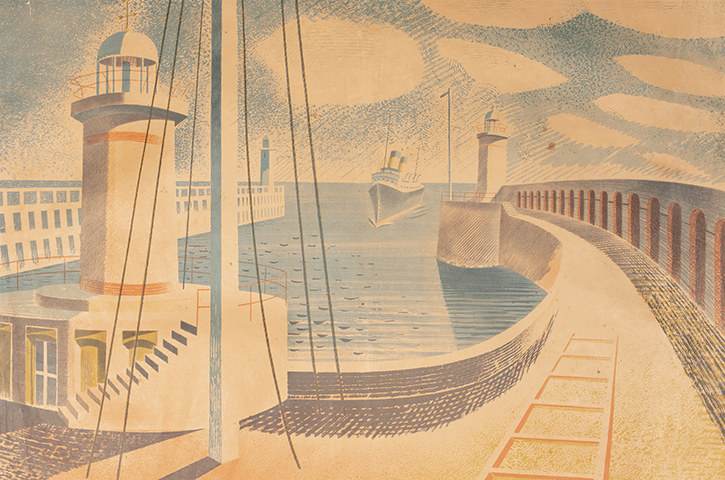
Ravilious stayed at Newhaven's Hope Inn during August and September 1935 with friend and fellow artist Edward Bawden. He had been commissioned to produce a lithograph for schools and found his inspiration for this among the 'attractive jetties and dredgers' of the harbour. He picked out the small lighthouses at the harbour mouth, including one with a signalling mast seen in the foreground of Newhaven Harbour, pictured against a cloudless blue sky. The 'James' and the 'Foremost Prince', with a belt of buckets and mud chute, suggests a Constructivist sculpture, whilst Channel Steamer Leaving Harbour captures the romance of the night ferry departure.
Channel Steamer Leaving Harbour
1935, watercolour by Eric Ravilious (1903–1942). On long-term loan to the Towner Collection from a private lender 
All of these works are in the collection of Towner Eastbourne, along with a large number of Ravilious's other paintings, ceramics, wood engravings and archive items.
The 'James' and the 'Foremost Prince'
1934, watercolour by Eric Ravilious (1903–1942). On long-term loan to the Towner Collection from a private lender 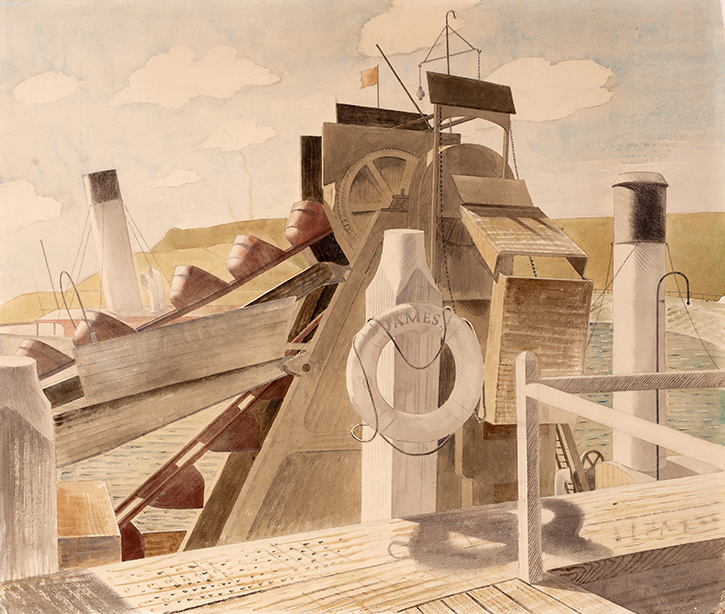
During a later Newhaven visit, from mid-September into October 1940, he made six paintings of this coastal town, now heavily fortified due to its targeting as part of Operation Sea Lion, the planned invasion of Britain by German forces. Climbing up to the fort, he painted its ditches and retaining walls perched on the cliffs and overlooking the beach scattered with barbed wire and harbour with military ships and long searchlight beams. It was a very different scene from the one he and Bawden had depicted five years earlier. A number of these Coastal Defence works are now held in the collections of the Imperial War Museum and Aberdeen Art Gallery.
Ravilious died in September 1942, aged just 39. As an official war artist on active service he had been posted to Iceland where, whilst on a search-and-rescue mission, the plane he was flying in was lost at sea.
A view of 'Following Ravilious – Newhaven Views', the free public art trail
Charlie Prodger's 'Vision Machines (Cliff)', 2023 
Much has changed since Ravilious's Newhaven visits in the 1930s and 1940s. However, the town still retains many of the elements that so fascinated him and continues to attract artists, designers and makers to this day. A new temporary public art trail, matching the four Ravilious images of Newhaven in Towner Eastbourne's collection with works by contemporary artists, has recently opened in the town. The four pairs of large-scale, billboard-sized artworks are positioned in accessible locations, within the landscapes that Ravilious depicted nearly a century ago. All the works can be seen and appreciated from far off as well as close up. One pair even sits astride the top level of a public car park!
The four Ravilious works are accompanied by a contemporary response from one of four artists – Emily Allchurch, Jo Lamb, Mark Titchner, and Charlie Prodger – who have carefully considered the historic paintings, and aspects of Newhaven as an industrial working port, gateway to France and Europe, home to many artists and creatives, and start of the South Downs experience for tourists and visitors. The artists were selected for their distinct artistic style, varied practice and their approach to the project.
'Following Ravilious – Newhaven Views', the free public art trail
Ravilious's artwork with Mark Titchner's 'Blessed are the eyes that see the things we see', 2023 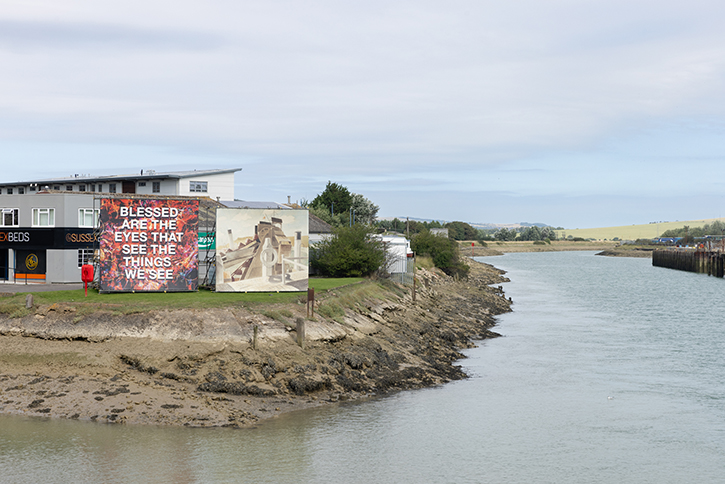
Mark Titchner, shortlisted for the Turner Prize in 2006, frequently produces large-scale works in the public realm and has a long-standing interest in incorporating words, text, and language. His Newhaven piece takes as its starting point Ravilious's interest in the collision of the East Sussex landscape with modern industry. Titchner wanted to consider the contested nature of contemporary industrial landscape, its environmental consequences, and the reality of living within it. His artwork adapts a biblical text that is inscribed upon the gravestone of Ravilious and his wife Tirzah Garwood, moving the emphasis of the sentence away from individual perception towards a collective reflection.
'Following Ravilious – Newhaven Views', the free public art trail
Ravilious's artwork with Emily Allchurch's 'Return to Por (After Ravilious)', 2023 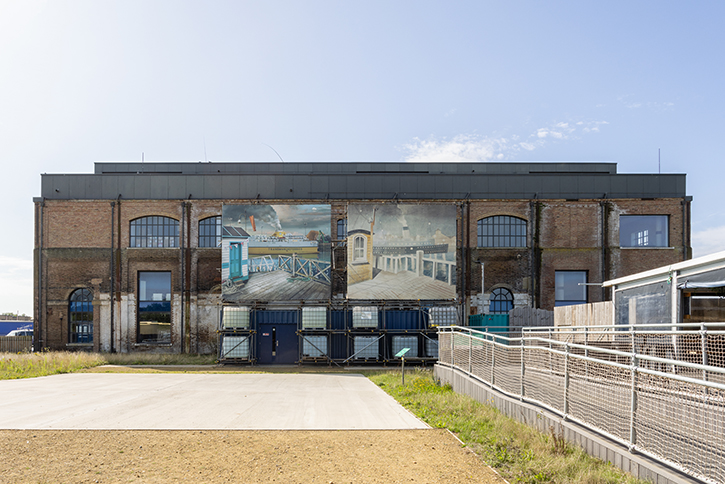
Emily Allchurch has lived and worked in Hastings since 2015. She uses photography and digital collage to reconstruct and update historical artworks from a contemporary perspective. For her work, she has taken Ravilious's Channel Steamer Leaving Harbour (1935) as her starting point. Concentrating on the Newhaven to Dieppe Transmanche/DFDS ferry which continues to cross the channel daily, she has captured the bright cabin lights and billowing steam from the ship's funnel, as well as various features of the port. Her interpretation captures the drama and anticipation of sea travel as well as the excitement of the ferry's arrival.
'Following Ravilious – Newhaven Views', the free public art trail
Ravilious's artwork with Jo Lamb's 'Early Morning', 2018 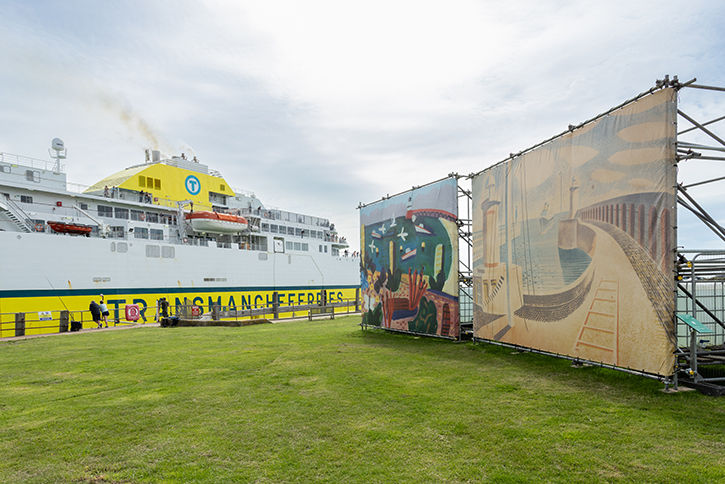
Similarly, the work of Jo Lamb also focuses on the busy harbour and the boats and ships going about their daily trips. Jo's Newhaven piece was selected to be shown in front of the iconic Hope Inn, alongside Ravilious's lithograph Newhaven Harbour, reflecting the same location over 80 years later. Jo's bright paintings often start with sketches, personal memories and photos, but they take on a universal quality through her use of composition and colour. A long-time admirer of Ravilious, she closely relates to his interest in place, and to Newhaven in particular. Her fascination and love of the harbour area – with its large and small boats and the ferry coming in and out past the lighthouses – are evident in her vibrant works.
'Following Ravilious – Newhaven Views', the free public art trail
Ravilious's artwork with Charlie Prodger's 'Vision Machines (Cliff)', 2023 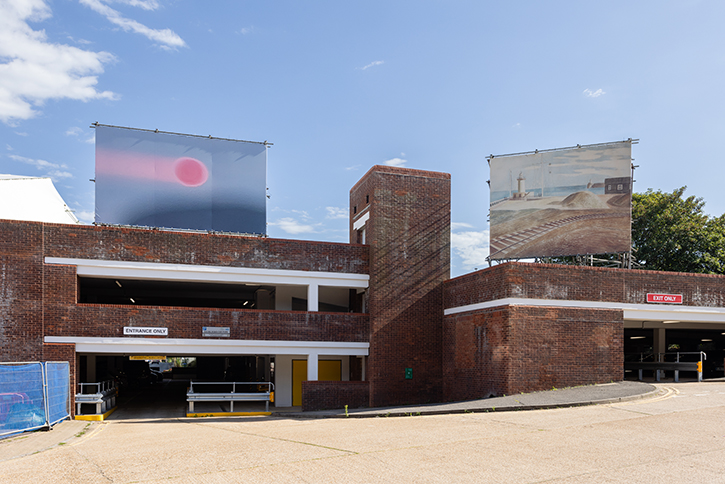
Winner of the Turner Prize 2018, Charlie Prodger was born in the south coast town of Bournemouth but is now based in Glasgow. An artist who works with moving image, writing, sculpture and printmaking, her work – a still taken from her newest film – is being shown on top of the town centre car park alongside Ravilious's Lighthouses at Newhaven. Moving image has been at the core of Prodger's work for two decades. She explores the intertwined relationships of the body, landscape, language, technology and time. Like Ravilious, she is interested in industrial materials and processes (aluminium, haulage tarpaulins, Perspex, powdercoating, RAL charts), particularly in her sculptural works.
'Following Ravilious – Newhaven Views', the free public art trail
Ravilious's artwork with Mark Titchner's 'Blessed are the eyes that see the things we see', 2023 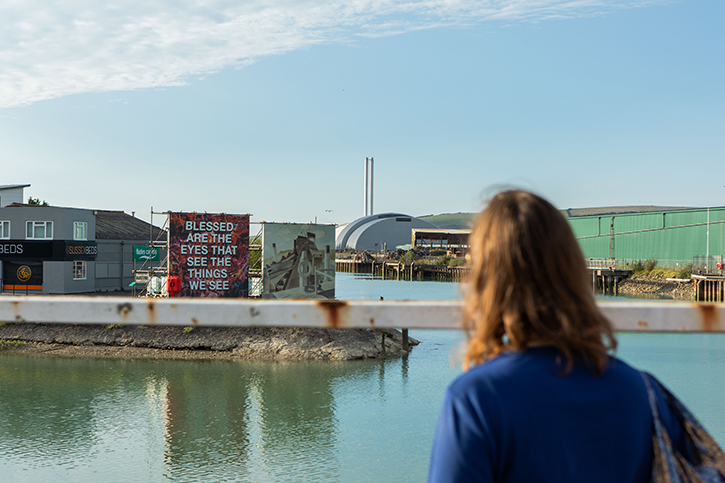
The timing of this outdoor exhibition coincides with Towner's centenary celebrations and the launch of the 2023 Turner Prize exhibition at the gallery at the end of September. The project reflects a new confidence among Newhaven's community that the town has a bright future. High levels of investment have recently flowed into the town, some of it on the back of a convincing artistic and cultural offer that combines performance and visual artists including painters, designers, makers and practitioners. This blurring of the roles and diffuse focus of the artistic community would certainly have been attractive to designer, painter, designer, and book illustrator Ravilious, had he been working in the town today.
Sara Cooper, Head of Collections & Exhibitions, Towner Eastbourne and Nick Stockman, Newhaven Creative Producer
'Following Ravilious – Newhaven Views' continues until Sunday 29th October. Keep up to date about associated events, including a screening of the film Ravilious at War and a talk by Ravilious biographer Andy Friend, both in Newhaven, from the Newhaven Enterprize Zone website and @creativenewhaven on Instagram and Facebook
